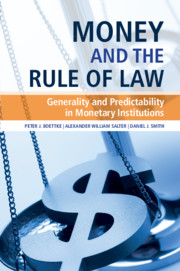Book contents
- Money and the Rule of Law
- Money and the Rule of Law
- Copyright page
- Dedication
- Contents
- Preface
- Acknowledgments
- 1 Introduction
- 2 Knowledge Problems with Discretionary Monetary Policy
- 3 Incentive Problems with Discretionary Central Banking
- 4 When Firefighters Are Arsonists
- 5 On the Shoulders of Giants
- 6 Money and the Rule of Law
- 7 Conclusion
- Index
- References
3 - Incentive Problems with Discretionary Central Banking
Published online by Cambridge University Press: 13 May 2021
- Money and the Rule of Law
- Money and the Rule of Law
- Copyright page
- Dedication
- Contents
- Preface
- Acknowledgments
- 1 Introduction
- 2 Knowledge Problems with Discretionary Monetary Policy
- 3 Incentive Problems with Discretionary Central Banking
- 4 When Firefighters Are Arsonists
- 5 On the Shoulders of Giants
- 6 Money and the Rule of Law
- 7 Conclusion
- Index
- References
Summary
Orthodox monetary policy scholarship assumes that central bankers act to maximize the public welfare. If imperfect incentives enter the model, it is on the part of the public. We challenge this assumption. Monetary policymakers are just as prone to incentive problems, which cause them to act according to their own self-interest. Furthermore, the self-interest of policymakers is not always the same thing as the public welfare. The two diverge frequently, in fact. We survey the history of the Federal Reserve and show the numerous ways discretionary central bankers have been compromised. These incentive problems are an inherent feature of discretion. They can only be eliminated by embracing true monetary rules.
Keywords
- Type
- Chapter
- Information
- Money and the Rule of LawGenerality and Predictability in Monetary Institutions, pp. 58 - 93Publisher: Cambridge University PressPrint publication year: 2021

